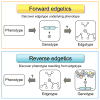Edgotype: a fundamental link between genotype and phenotype
- PMID: 24287335
- PMCID: PMC3902775
- DOI: 10.1016/j.gde.2013.11.002
Edgotype: a fundamental link between genotype and phenotype
Abstract
Classical 'one-gene/one-disease' models cannot fully reconcile with the increasingly appreciated prevalence of complicated genotype-to-phenotype associations in human disease. Genes and gene products function not in isolation but as components of intricate networks of macromolecules (DNA, RNA, or proteins) and metabolites linked through biochemical or physical interactions, represented in 'interactome' network models as 'nodes' and 'edges', respectively. Accordingly, mechanistic understanding of human disease will require understanding of how disease-causing mutations affect systems or interactome properties. The study of 'edgetics' uncovers specific loss or gain of interactions (edges) to interpret genotype-to-phenotype relationships. We review how distinct genetic variants, the genotype, lead to distinct phenotypic outcomes, the phenotype, through edgetic perturbations in interactome networks altogether representing the 'edgotype'.
Copyright © 2013 Elsevier Ltd. All rights reserved.
Figures




References
Publication types
MeSH terms
Grants and funding
LinkOut - more resources
Full Text Sources
Other Literature Sources

